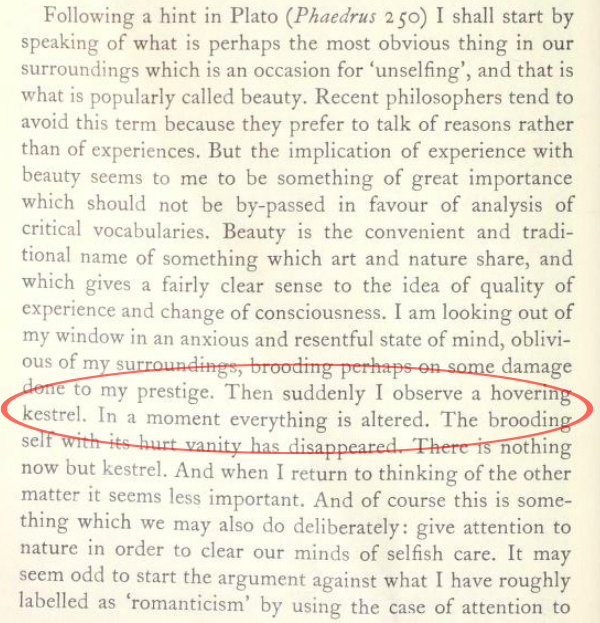Evidence of a Volée of German Psychophysicians c. 1860

Recently, while contributing research to a study of “Birdish” bookmarks in the Milcom Library Collection, an associate of ESTAR(SER) made a fascinating discovery. His notice on the matter has just crossed our desk, and we reproduce it here in full:
I was asked by my colleagues in ESTAR(SER) to retrieve a single quotation from the work of Gustav Theodor Fechner (1801-1887) pertaining to the historicity of the Order of the Third Bird, but in searching for it I stumbled on something that may be of interest for our collective research beyond any shorter-term projects we have. To wit, I have discerned in Fechner’s Elemente der Psychophysik (1860) evidence of a lost practice of attention under conditions of total darkness.
Fechner cites a number of earlier authors writing on the familiar phenomenon whereby someone who stays in a dark space for an extended time comes to perceive objects in that space to which a person just arrived from the outdoor light would be completely blind. Buffon, for one, describes a prisoner who after some months in a pitch-black cell was able to observe the mice he shared it with as if they were bathed in a rich luminosity.
Fechner is guardedly interested in the work of his near-contemporary Carl Ludwig von Reichenbach (1788-1869), who in his Odisch-magnetische Briefe (1859) introduces the concept of the Od. This term is derived from the Old Norse ōðr, commonly translated as “feeling,” but also having the sense of “song” or “poetry.” Reichenbach appropriates it and Germanizes it to describe a life-force that steers the body and that can be detected emanating out of it under the right experimental conditions. This od or “odic force” is conceived as something akin to both electricity and magnetism, and to this extent is but one expression of many in the era of a broad interest, best exemplified in the work of Franz Mesmer (1734-1815), in explaining the activity of living bodies in terms of fundamental physical forces that were only beginning to be understood.
What interests Fechner most in Reichenbach’s work, however, is the capacity this latter author attributes to the so-called Sensitives: people who have unusual powers due to the greater share they possess of the odic force. Reichenbach’s Sensitives, Fechner observes, “see, in total darkness, a glowing, at the poles of strong magnets of flame-like appearances of light; at the north pole they perceive blue and blue-grey, at the south pole red, red-yellow, and red-grey.” Reichenbach also maintains, Fechner notes, “that they see a glowing at the points of crystals, at the extremities of living human, animal, and plant bodies, particularly at the fingertips, in metals, sulphur, and fluids that are obtained in chemical reactions or in crystallisation, and so on. The author arrives in the end at the result,” Fechner concludes, referring to volume II of Reichenbach’s Der sensitive Mensch und sein Verhalten zum Ode (1855), “that all bodies on the earth in general give off a light in the darkness that is detectable by Sensitives, only that some do so more, and some less.”*
Who are these “Sensitives”? Intriguingly, in a footnote to the second edition of the Elemente der Psychophysik (Leipzig, 1861), Fechner comments that he has heard of a contingent of Reichenbach’s followers who describe themselves by this term, and who, Fechner believes, cultivate their sensitivity even beyond their innate capacity through what he describes as Aufmerksamkeitsübungen, i.e., exercises of attention. Fechner writes: “Thus do they sharpen their sensitivity: in total darkness they direct their eyes, all together and for a fixed period of time, towards one and the same art object, until they detect its glowing. Some of them maintain that in the perception of this glowing the sensitive observer temporarily shares in the same inner nature as the observed object.”**
Could this be evidence for the existence of a volée of the Order within the cultural nexus of the not-quite-fringe yet not fully credence-worthy German psychophysicians of the mid-19th century? Clearly, further research is required.
*“Reichenbach giebt in seinen Schriften über das sog. Od an, dass gewisse Personen, sog. Sensitiven, im vollkommenen Dunkel an den Polen starker Magnete flammenähnliche Lichterscheinungen, am Nordpole blaue und Blaugraue, am Südpole eine rothe, rothgelbe und rothgraue wahrnehmen, dass sie auch die Spitze von Krystallen, lebende menschliche, thierische und pflanzliche Körper, ganz besonders die Fingerspitzen, Metalle, Schwefel, Flüssigkeiten, die im chemischen oder Krystallisationsacte begriffen sind, u. s w. leuchten sehen. Endlich kommt der Verf. (sensit. Mensch II. S. 192) zu dem Resultate, dass alle Körper der Erde überhaupt im Dunkeln Licht, für die Sensitiven spürbar, ausgeben, die einen nur mehr, die anderen weniger” (323-24).
**“So schleifen sie ihre Empfindlichkeit: im vollkommenen Dunkel richten sie die Augen alle zusammen für eine bestimmte Zeit auf ein und dasselbe Kunstobjekt, bis sie das Leuchten davon spüren. Einige von ihnen behaupten, dass beim Beobachten dieses Leuchtens der sensitive Beobachter dasselbe innere Wesen als der beobachtete Gegenstand vorübergehend teilt.”
We agree with our associate: further research is required. Anyone inclined to pursue the topic will be interested to recall that this is not the first time occult tendencies have surfaced in the historicity of the Order. In the late eighteenth and early nineteenth centuries, most notably, the English antiquarian (and probable Bird) Francis Douce (1757-1834) experimented on the “attentional landscapes” putatively perceived by Welsh and Irish clairvoyants blessed with second sight; subsequently, in the early twentieth-century, a cohort of figures in and around Britain appears to have formalized Douce’s esoteric methods into a “Corona of Care” protocol, the first phase of which is “Watch the Darkness.” Could Reichenbach have been aware Douce? Could the protocol be linked to Reichenbach?
We are passing the matter on to ESTAR(SER)’s “Standing Committee on Practical Auratics” for further investigation. In the meanwhile, do not hesitate to send critical responses or promising leads to the Editor of the Communiqués.













